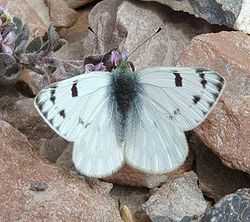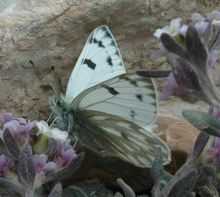Pontia callidice
| Lofty Bath White | |
|---|---|
 | |
| Indian Lofty Bath White (Pontia callidice kalora) at Chandratal Lake (14000 feet), near Manali, India. | |
| Scientific classification | |
| Kingdom: | Animalia |
| Phylum: | Arthropoda |
| Class: | Insecta |
| Order: | Lepidoptera |
| Family: | Pieridae |
| Genus: | Pontia |
| Species: | P. callidice |
| Binomial name | |
| Pontia callidice Hübner 1799-1800 | |
| Synonyms | |
|
Synchloe callidice | |
The Lofty Bath White or Peak White (Pontia callidice) is a small butterfly of the family Pieridae, that is, the Yellows and Whites, which occurs in the Palearctic zoogeographical region.
Description
Description from Bingham, C.T. (1907) The Fauna of British India, Including Ceylon and Burma. Butterflies, Volume 2:pp. 178–179
600. Pieris callidice
(=Pieris kalora, Moore, P.Z.S. 1865:449)
Male

Underside view of Indian Lofty Bath White (Pontia callidice kalora).
- Upperside: white.
- Forewing: black at extreme bases of interspaces 1a and 1 and of cell; discocellulars marked with a quadrate black spot; a discal curved series of inwardly dentate spots, the spots in interspaces 1 and 2 generally reduced to a mere trace, often absent; an anterior terminal series of similar but more clearly defined spots at the apices of veins 3 to 7.
- Hindwing: uniform, the pattern of the underside visible through transparency; base densely irrorated with black scales.
- Underside.
- Forewing: white; basal half of costal margin and quadrate spot on discocellulars dull black; a discal curved series of four black spots in interspaces 1, 3, 5 and 6, followed by elongate streaks of green along veins 3 to 7 that extend to the termen.
- Hindwing: green, an elongate oval yellowish-white spot in cell, followed beyond by complete curved series of discal and terminal yellowish-white, inwardly lanceolate spots. Antennae black, spotted with white, head fuscous grey, thorax blackish grey, abdomen black with more or less sparse white scaling; beneath: head, thorax and abdomen white.
Female
- Upperside. Similar to that of the male, the black scaling at the base of the wings more extended, especially on the hind wing where it stretches broadly down the dorsal half of the wing and occupies also the apex of the cell.
- Forewing: the irroration of black scales along the basal half of the costal margin and discocellular quadrate black spot as in the male, the latter, however, broader; the apex and terminal third of the wing above vein 2 dusky black, with a series of elongate white spots in the interspaces, the inner margin of the black area curved but very jagged; lastly, a geminate transverse black spot in the outer half of interspace 1.
- Hindwing: a terminal series of large, inwardly acute pointed, black spots with oval white centres and a large costal black spot before the apex.
- Underside.
- Forewing: the ground-colour and markings much as in the male, but the green on the apex and termen more extended, the white streaks that traverse it longer; the black discal spots in interspaces 5 and 6 absent.
- Hindwing: similar to that of the male, but the yellowish-white lanceolate spots narrower nad smaller. Antennae, head, thorax and abdomen as in the male. In both sexes the antennae are not generally typical, the club abrupt, shorter and broader.
Expanse: 53–60 mm.
Range
Within India: NW Himalayas above 12,000 feet from Chitral to Mussoorie. Occurs also in the higher mountains of Europe; in Asia from the Altai to the Himalayas; and in China. (Bingham, 1907)
Habitat
High altitude in alpine meadows, above the treeline.
See also
References
- Bingham, C.T. (1907) The Fauna of British India, Including Ceylon and Burma. Butterflies. Volume 2.
- Evans, W.H. (1932) The Identification of Indian Butterflies. (2nd Ed), Bombay Natural History Society, Mumbai, India
- Haribal, Meena (1994) Butterflies of Sikkim Himalaya and their Natural History.
- Wynter-Blyth, M.A. (1957) Butterflies of the Indian Region, Bombay Natural History Society, Mumbai, India
| Wikimedia Commons has media related to Pontia callidice. |